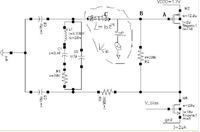simao
Newbie level 4
32.768khz crystal inductance
hi, all
I am designing a 32.68kHz crystal oscillator now and have some problemes.
1. The quartz crystal i will use is FC135 of EPSON, in designing i need a equivalent crystal model to simulate, the parameters from datasheet of fc135 is listed below:
motional capacitance(C1):3.4fF
series resistance(R1):70Kohm max.
shunt capacitance(C0):1pF
load capacitance(CL):9pF or 12.5pF
now my question is does the motional inductance can be calculated by equation fs=1/[2*pi*(C1*L1)^0.5] ?
the L1 i calculated by this equation and value of C1=3.4fF is about 6.9KH, does this value correct? and if the value is too large?
2. I simulated the crystal oscillator by spectre and found that the circuit can't oscillate, when i give L1 a initial current as 10nA, i got a sine wave with a decreased amplitude, and when i give a 50nA initial current i got a sine wave with a increased amplitude, the question is if i simulate the circuit at a 50 nA initial current of L1 it will work correctly but when i implement the chip can it work correctly? does the initial current of the L1 have some limit?
3. The inverter i designed need about 6uA DC current to get a transconductance(gm) larger than 80uS to make it oscillator, but the specification of the supply current is no more than 3uA, is there any mearment to get a larger transconductance without increasing the dc current?
thanks very much for you attention!
hi, all
I am designing a 32.68kHz crystal oscillator now and have some problemes.
1. The quartz crystal i will use is FC135 of EPSON, in designing i need a equivalent crystal model to simulate, the parameters from datasheet of fc135 is listed below:
motional capacitance(C1):3.4fF
series resistance(R1):70Kohm max.
shunt capacitance(C0):1pF
load capacitance(CL):9pF or 12.5pF
now my question is does the motional inductance can be calculated by equation fs=1/[2*pi*(C1*L1)^0.5] ?
the L1 i calculated by this equation and value of C1=3.4fF is about 6.9KH, does this value correct? and if the value is too large?
2. I simulated the crystal oscillator by spectre and found that the circuit can't oscillate, when i give L1 a initial current as 10nA, i got a sine wave with a decreased amplitude, and when i give a 50nA initial current i got a sine wave with a increased amplitude, the question is if i simulate the circuit at a 50 nA initial current of L1 it will work correctly but when i implement the chip can it work correctly? does the initial current of the L1 have some limit?
3. The inverter i designed need about 6uA DC current to get a transconductance(gm) larger than 80uS to make it oscillator, but the specification of the supply current is no more than 3uA, is there any mearment to get a larger transconductance without increasing the dc current?
thanks very much for you attention!
